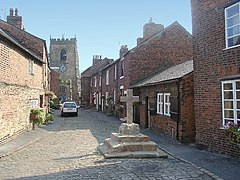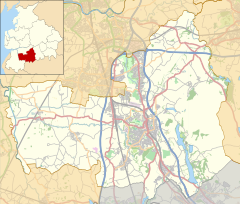Croston is a village and civil parish near Chorley in Lancashire, England. The River Yarrow flows through the village. The population of the civil parish taken at the 2011 census was 2,917.[1]
| Croston | |
|---|---|
 Church Street, Croston village centre | |
Location within Lancashire | |
| Population | 2,917 (2011 Census) |
| OS grid reference | SD487187 |
| Civil parish |
|
| District | |
| Shire county | |
| Region | |
| Country | England |
| Sovereign state | United Kingdom |
| Post town | LEYLAND |
| Postcode district | PR26 |
| Dialling code | 01257/01772 |
| Police | Lancashire |
| Fire | Lancashire |
| Ambulance | North West |
| UK Parliament | |
History edit
Croston was founded in the 7th century when St Aidan arrived at the riverside settlements. In the absence of a church, a cross was erected as a place of worship. The name is derived from the two Old English words 'cross' and 'tūn' (town/homestead/village) and is unique to the village.
The parish of Croston was formerly far larger than it is today. It included Chorley, Much Hoole, Rufford, Bretherton, Mawdesley, Tarleton, Hesketh Bank, Bispham, Walmer Bridge and Ulnes Walton. These became independent parishes as a result of a series of separations between 1642 and 1821.[2] A charter granted by Edward I in 1283 permitted an annual medieval fair and market to be held on the village green. Pre-20th Century maps also depict a castle which is believed to have been of a wooden construction because there is no evidence of a stone structure.
Croston is twinned with the French town of Azay le Rideau, just south west of Tours, France.[3] Azay boasts a French Renaissance chateau, one of the famous chateaux of the Loire, and is a popular tourist hotspot.
Landmarks edit
Croston Hall was built by the De Trafford family and was the manor house to the village of Croston. The hall was demolished in the 1960s, but there is a new country house built on its site. The family were Roman Catholics, and employed Edward Welby Pugin to design a family chapel in the grounds of the house in 1857. It is a small building constructed of rock-faced sandstone and is in eclectic Gothic style.[4] It was left to the people of Croston on the death of the last De Trafford in the 1960s.
Croston used to have a large brick police station which has recently been refurbished. It was replaced by a smaller police station in the 1970s, which itself has now closed.
Transport edit
Croston railway station serves the village and is on the Ormskirk Branch Line, originally built & opened by the Liverpool, Ormskirk and Preston Railway (later taken over by the Lancashire and Yorkshire Railway) in 1849.[5] The rail link was reduced to single-line working in 1970. Croston has bus connections to nearby Leyland, Chorley, Southport, and Preston.
Education edit
Bishop Rawstorne Church of England Academy is the secondary school based in the village. It has between 800 and 900 pupils from the ages of 11 to 16.[6]
The footballer Mark Bonner played professionally for a number of years at Blackpool. Andrew Sprake the bassist from the band Failsafe, who featured in an episode of Inbetweeners, also studied here. The DJ Dave Dawson also studied here. Dave makes the Mind the gap announcements on the Docklands Light Railway.
Croston Old School is now a community resource centre. The building is a Grade II listed building which originates from 1660 but was substantially rebuilt in 1827, when the work was funded by subscriptions. Date stones commemorating both the original build and the rebuild are evident in the first-floor wall. It is located within the churchyard,[7] in the centre of the village at the end of Church Street and next to the church building. Until 1999 the buildings were used as a school. Croston Old School Community Trust's grant from the National Lottery for £481,062 has funded the majority of a scheme to create a community resource centre for Croston.
The building provides:
- A Pop-up cafe on Weds and Thurs mornings
- A large community space with meeting rooms
- Is the home of the photographic archives of Croston
Religion edit
The parish church is dedicated to St Michael and All Angels, and is a Grade II* listed building.[8] It appears to be based on a 15th-century design, but was reworked in the 16th century, and altered in the 17th. A partial rebuilding took place in the 18th century, and it was substantially altered in the 19th century. It consists of a nave and chancel with north and south aisles, mostly built of red sandstone with stone tiles.[2] Croston Old School is located within the Churchyard.
A payment was made of farm rents amounting to £50,000 per year collected in fixed proportions by the Rectors of Croston, Hoole, Chorley, Rufford, and Tarlton and which until at least 1910 was paid to the representatives of the Hon. Mrs. Dashwood whose ancestor had purchased the rights in the reign of Charles II. This income had been taken by Henry VIII from the Convent of Zion at the time of the Dissolution and sold. The funds taken were those used to fund religious houses. The Churchyard had been the site of Becconsall chapel until 1660, when the Reverend James Hyett built the school there. He had been appointed to his post by Charles I in 1625, but by 1662 he felt unable to conform to the Act of Uniformity and was ejected from the Church, he died the same year and in his will left an endowment to the school. Rev Hyett was succeeded by Rev. James Pilkington, elder brother of Elizabeth Breres who with her husband held the Manor of Rivington[9]
See also edit
References edit
- ^ UK Census (2011). "Local Area Report – Croston Parish (E04005148)". Nomis. Office for National Statistics. Retrieved 26 March 2021.
- ^ a b Farrer & Brownbill 1911, pp. 81–91.
- ^ Mayoh, Emma (9 January 2012). "Croston's success is down to the growing support of the local community". Lancashire Life. Archant Community Media. Retrieved 27 June 2013.
- ^ Historic England. "Roman Catholic Church of the Holy Cross (1072549)". National Heritage List for England. Retrieved 15 December 2014.
- ^ CRL - Croston Community Rail Lancashire; Retrieved 22 November 2016
- ^ "Bishop Rawstorne Church of England Academy". Bishop Rawstorne Church of England Academy. Bishop Rawstorne Church of England Academy. Retrieved 15 September 2019.
- ^ Historic England. "School in churchyard of Church of St Michael (1072547)". National Heritage List for England. Retrieved 14 December 2014.
- ^ Historic England. "Church of St Michael (1163631)". National Heritage List for England. Retrieved 14 December 2014.
- ^ Procter, B.A., Rector of Rufford, Rev. W. G. (1910). THE ANCIENT PARISH OF CROSTON : A HISTORICAL RETROSPECT. PART II (PDF). England: Historic Society of Lancashire and Cheshire. pp. 35..38. Retrieved 15 September 2019.
{{cite book}}: CS1 maint: multiple names: authors list (link)
Bibliography edit
- Farrer, William; Brownbill, J, eds. (1911). A History of the County of Lancaster. Vol. 6. Victoria County History.
External links edit
- Croston Main Page
- Croston Village Festivities website Archived 11 February 2011 at the Wayback Machine
- Croston Facebook Page
- Croston chorley.gov.uk.

